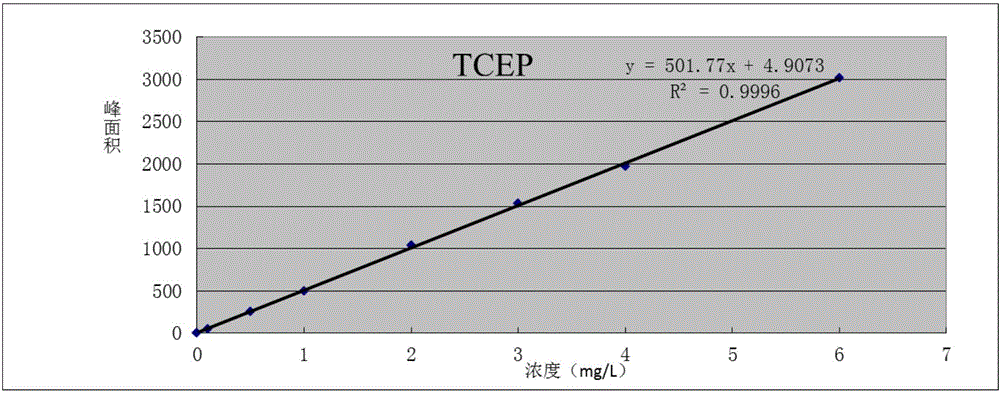Method for detecting tris(2-chloroethyl)phosphate (TCEP) in water sample by using liquid chromatography
A technology of liquid chromatography and detection method, which is applied in the field of detection of TCEP in water samples by liquid chromatography, which can solve the problems of large amount of organic solvent, high cost of equipment and low accuracy, and achieve high recovery rate and low reagent cost. Low, high accuracy effects
- Summary
- Abstract
- Description
- Claims
- Application Information
AI Technical Summary
Problems solved by technology
Method used
Image
Examples
Embodiment 1
[0043] Embodiment 1-a kind of detection method that liquid chromatography measures TCEP in the water sample:
[0044] A: Preparation of experimental equipment
[0045] High performance liquid chromatography - differential refractive index detector (Agilent)
[0046] Gemini C18 reversed-phase column
[0047] 0.45μm polyethersulfone filter head
[0048] B: Preparation of reagents
[0049] Standard product: TCEP (purity 97.0%, produced by SIGMA-ALDRICH company)
[0050] C: Specific detection steps:
[0051] Adopt high-performance liquid chromatography-differential refractive index detector to detect, comprise the following steps:
[0052] (1) Standard solution preparation: get 100ml volumetric flask, put into electronic balance, peel, add TCEP with dropper, weigh 0.1142g into the volumetric flask, then use ultrapure water to make up the volume, be made into the stock solution of 4mmol / L;
[0053] Preparation of TCEP standard solution: Accurately pipette an appropriate amount ...
Embodiment 2
[0063] Example 2: Linear Relationship
[0064] Under the preferred detection conditions in the above-mentioned embodiment 1, TCEP is detected in the concentration range of 0.1~6.0mg / L, and the standard curve of the obtained TCEP is shown in figure 2 ,Depend on figure 2 It can be seen that the concentration has a good linear relationship with the peak area, the linear equation is: Y=501.77X+4.9073, and the correlation coefficient R2=0.9996.
Embodiment 3
[0065] Embodiment 3: detection limit
[0066] Under the preferred detection conditions in the above-mentioned embodiment 1, the standard sample of 0.1 mg / L concentration was repeatedly measured 8 times, and the minimum detection concentration of TCEP obtained by calculating 3 times of standard deviation was 0.008 mg / L, as shown in Table 1:
[0067] Table 1 Detection limit test of TCEP
[0068]
PUM
| Property | Measurement | Unit |
|---|---|---|
| pore size | aaaaa | aaaaa |
Abstract
Description
Claims
Application Information
 Login to View More
Login to View More - R&D
- Intellectual Property
- Life Sciences
- Materials
- Tech Scout
- Unparalleled Data Quality
- Higher Quality Content
- 60% Fewer Hallucinations
Browse by: Latest US Patents, China's latest patents, Technical Efficacy Thesaurus, Application Domain, Technology Topic, Popular Technical Reports.
© 2025 PatSnap. All rights reserved.Legal|Privacy policy|Modern Slavery Act Transparency Statement|Sitemap|About US| Contact US: help@patsnap.com



